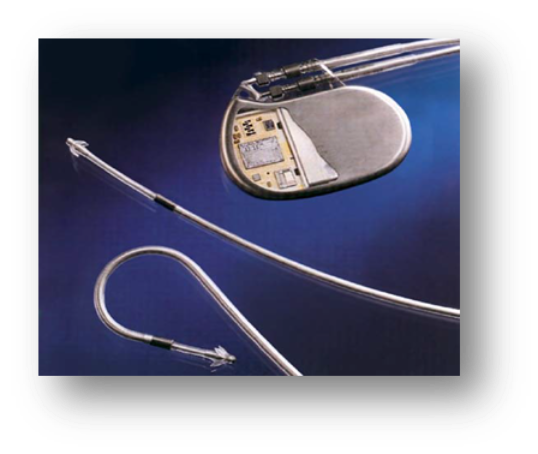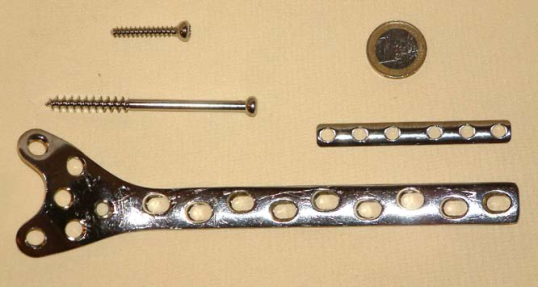- Artificial Intelligence (AI)
- Occupational exposure limit values
- Climate Change and Occupational Safety
- List of CMR substances
- Ergonomics
- EU GHS Regulation
- Industrial Security
- Collaborative robots
- Noise
- Nanoparticles at the workplace
- REACH
- Reference materials
- Proficiency testing
- Radiation
- Vibration
- Virtual reality
- Work 4.0
Employees with implants

A cardiac pacemaker is an active implant.
Source: Image: DGUV Informative publication 203-043
Electric, magnetic and electromagnetic fields can influence passive implants and impair their function. Such implants include artificial joints and bone screws/plates; active implants such as cardiac pacemakers, defibrillators/ICDs (implantable cardioverters and defibrillators) with a therapeutic function for ventricular fibrillation in addition to their pacemaker function; neurostimulators; cochlear implants; and insulin pumps. These devices may be influenced even when the action limits in accordance with the German Ordinance on the protection of workers against hazards presented by electromagnetic fields (EMFV) are observed at the workplace. A dedicated risk assessment that considers these devices must therefore always be performed for persons fitted with implants.
The assessment must also consider and examine the wearing of metal body jewellery, such as piercings. Owing to their small dimensions, dental fillings are generally disregarded.
Interference with passive and active implants is evaluated by the IFA on behalf of the German Social Accident Insurance Institutions. The provision of the affected individuals with comprehensive advice and information is always important. Not every workplace requires a separate evaluation. A useful overview of a range of devices and installations and an evaluation of the possible interference with active implants caused by their respective field sources can be found in Annex 1 of DGUV Informative publication 203-043 (PDF, 48 kB, non-accessible) , in German.

Examples of passive implants: bone screws and metal plates used for plate osteosynthesis
Source: DGUV Informative publication 203-043
Interference with implants
The effects of electromagnetic fields upon implants depend upon factors including the frequency and type of the fields.
Depending upon their material composition, passive implants may be subject to forces generated by static magnetic fields or to heating of the implant by low-frequency or high-frequency fields.
Active implants are subject to disruptive interference primarily from low-frequency magnetic fields. High-frequency electromagnetic fields and low-frequency electric fields are attenuated sufficiently by integral filters in active implants and by the body tissue for influence upon these implants to be unlikely.
Functional impairment of an active implant caused by interference may pass unnoticed by the individual fitted with it. Depending upon the nature of the impairment, it may however lead to cardiac discomfort, cardiac arrhythmia, or in the worst-case scenario even to death. Further information can be found in DGUV Informative publication 203-043 (previously: BGI/GUV-I 5111).
Evaluation of interference
Disruptive interference in implants can be evaluated either generically or on a case-by-case basis. A generic evaluation is based upon the permissible values (threshold values) stated in Research Report 451 concerning the safety of workers fitted with active and passive implants under exposure to electromagnetic fields (in German).
If the evaluation is to be limited to a specific person within a defined working area, a person-specific evaluation of the interference is recommended. This takes account of the specific properties and settings of the individual's implant(s). In the majority of cases, this evaluation enables the affected individual to continue working or to return to work with virtually no constraints.
Mandatory reporting

Workers have a duty under DGUV Regulation 15, Section 12 (3) to inform their employers that they have been or will be fitted with an implant. This is necessary in order for the employer to take measures, where required, to protect employees against potential hazards.
Contact
Accident Prevention: Digitalisation - Technologies
Tel: +4930 13001-3580Fax: +4930 13001-38001
Carsten Alteköster
Accident Prevention: Digitalisation - Technologies
Tel: +49 30 13001-3581Fax: +49 30 13001-38001
Dr Florian Soyka
Accident Prevention: Digitalisation - New Technologies
Tel: +49 30 13001-3583Fax: Fax: +49 30 13001-38001